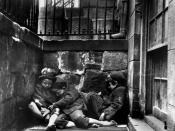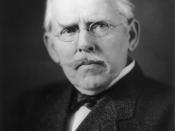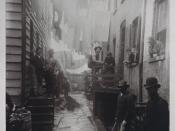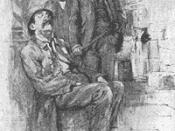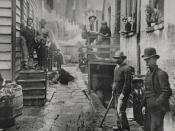The famous legendary hero who saved the many lives of poverty had made a name for himself. He's the man who improved the many lives of others and his unselfish acts convinced others that he's a hero with heart. Jacob A. Riis was an American journalist, photographer, and social reformer. He helped improve the living conditions in New York City slums by exposing them to the public through his writings and photographs. His photographs were among the first to appear in newspapers.
He was born in Ribe, Denmark on May 4, 1849 and was raised by his father. He was educated by his father and a private tutor, and later became a carpenter's apprentice. When he was unable to find work, he immigrated to America in 1870 at the age of 21. For the first seven years in America, Riis worked odd jobs and that was when he developed his sympathy for the poor.
He was a man with many achievements with stories told from one to another. According to his contemporaries, in 1877, Riis got a job as a police reporter for the New York Tribune. His colleague, Lincoln Steffens says, "Riis was a reporter who not only got the news, but cared about it. He was more concerned with the stories of people and the conditions in which they lived."àAccording to Theodore Roosevelt in the introduction of Making of An American, he says, "He was one of my truest and closest friends. I have not only admired and respected him beyond measure, but I have loved him dearly"æ and I mourn him as if he were one of my one family."àRiis's friends had remembered the best of Riis and they only spoke highly of him, but what about the people who looked back upon him? How did the people after his time view Riis? The photographic work of Jacob Riis was overlooked until 1947, when Alexander Alland, a photographer, made excellent enlargements from the original glass negatives. Through Alland's efforts, by 1948, he revealed Riis as a photographer of importance. "His photographs are direct and penetrating,"àAlland says. "He was always sympathetic to people, whether he was photographing street Arab steeling in the street from a handcart, or the inhabitants of the alley known as Bandits' Roost,"àsays an unknown historian. Ansel Adams sees Riis's photography works as "impressions of competence, integrity and intensity."àWhen Adam examines Riis's work, he finds himself identified with the people photographed. Riis captures a fragment of the world without identifying himself with his immediate environment.
In Ragtime by E.L. Doctorow, Doctorow finds an effective way to dramatize the living conditions of the poor. He introduces Jacob Riis as the famous "muckraking"ÃÂ journalist who starts as a police reporter. He conjures up an assignment for Riis, which is to interview Stanford White, the architect of the rich, to gain his ideas on housing for the poor, but Riis finds White too busy to be interviewed. He makes the readers see Riis as a man who wants and does make a difference in the lives of the slum.
